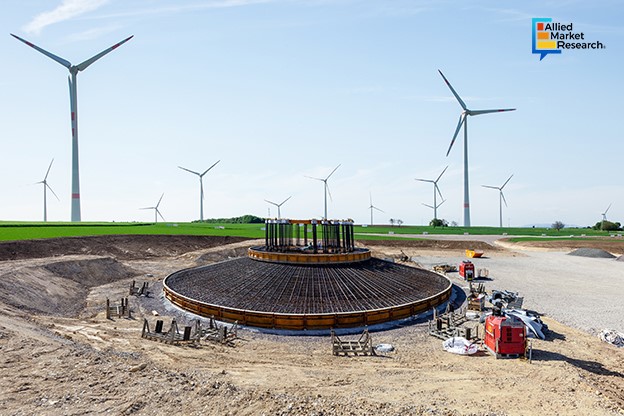Investing in Which Types of Offshore Wind Turbine Foundations Can Make Your Business Generate More Revenues?

6 Feb
2024
Focal Points:
- Major types of offshore wind turbine foundations
- Light on some cost-effective innovations
- Regional and country-level analysis of the domain
Wind turbine foundations are unique civil engineering structures that have gained huge popularity in recent years. These structures are designed to give support to the wind turbines, strengthening their stability of functioning. They can be made mainly in two areas; land and offshore, where there is a high prevalence of wind. Most wind turbine foundations are constructed in shallow water to allow wind turbines to bear the pressure of wind to generate electricity. A lot of calculations are made before constructing these robust structures. Some important points while making these foundations include a lower dead-load to wind-load ratio, higher dynamic load-bearing capacities, and greater strength for pressure distribution. In this article, we will discuss various types of offshore wind turbine foundations and their contribution to electricity generation.
Which are the popular types of offshore wind turbine foundations?
Most offshore wind power foundations are used to utilize the potential of wind in open seas, where usually the flow of wind is stronger than land. However, the installation of these foundations is quite complex as it requires wide analysis and calculation to elevate wind turbines and substations above sea level and anchor them to the seabed. There are different types of wind turbine foundations based on the depth at which the wind turbine is going to be installed.
Steel monopile foundations are one of the common types of offshore wind turbine foundations that consist of a single steel or concrete pile driven into the seabed. These structures are mainly constructed in shallow water less than 35m. They can be adaptable to deeper installations of various sizes and possess simple designs that can be installed quickly. Monopile constructions are cost-effective and work well in sand and gravel soils. Because of their flexible construction options, the monopile foundation segment is predicted to grow at the fastest CAGR of 5.9% during 2023-2032. However, these structures also have some drawbacks like high material needs and higher installation costs. Moreover, they have significant impacts on marine life by creating potential noise and vibration.
Jacket offshore wind turbine foundations are one of the popular types of civil engineering structures that are connected to the wind turbines through a transition piece. Jacket foundations are mainly composed of a lattice-truss structure of steel tubes that completely rest on the seabed. These structures are more complex and expensive than monopile foundations. They are highly suitable for deeper installations up to depths of 60 m. A notable example of a jacket foundation is Rhode Island’s Block Island Wind Farm which resembles offshore oil platforms with four tubular legs connected by diagonal struts. The biggest advantage of these foundations is that they can be installed using piles or suction caissons in stiff clays or medium to dense sands. The mechanism behind their construction offers higher stiffness and stability and lower weight and material consumption. Moreover, the structures also perform better in deeper waters and harsher environments.
Can wind turbine foundations save money and time: Some latest innovations
Over the past few years, wind turbine foundations have been continuously growing, however, many leading players in this domain have come up with innovative solutions that can help reduce material and excavation costs remarkably. For example, CTE Wind Civil Engineering SA, a French company specializing in the design and calculation of onshore foundations for wind turbines, developed a new solution, namely, Soft-Spot. This solution can optimize the functioning system of flat foundations by integrating structural engineering practices. It includes the placement of a soft layer of expanded polystyrene (EPS) under the center of the foundation which can help wind to dissipate radially into the ground rather than over the entire surface.
Moreover, the Soft-Spot solution has also proven its reliability by being used in sites across various nations including France, Sweden, Poland, Finland, Thailand, and even in the Netherlands, showing its prominence in handling concentrated ground pressure of the wind turbines. Arjan Louvewerse, the project manager of a Netherlands-based project where Soft-Spot® was utilized, said, “They have a good feeling while designing onshore hore wind turbine foundation by using Soft-Spot as it strengthens their philosophy of reducing costs by saving huge amounts in materials and designing works.”
Which region has gained the highest number of wind turbine foundation projects?
The wind turbine foundation industry is evaluated across various regions including North America, Aisa-Pacific, Europe, and LAMEA. Among all, the Aisa-Pacific region is projected to continue a steady growth during 2023-2032. This is mainly because of the growing demand for monopile foundations, jacket foundations, and innovative designs due to the increasing shift of countries of this region towards embracing renewable energy sources. However, based on country-wise analysis, China is expected to grow at a healthy CAGR of 5.9% during the estimated period because the nation is continuously incorporating various pile foundations, mat foundations, and concrete foundations to address soil conditions effectively.
To conclude, the sector is experiencing prominent growth due to the increasing advancements in wind turbine technology to develop robust foundations supporting increased tower heights and rotor sizes of wind turbines. In addition, the growing emphasis on framing specialized offshore foundation designs to reduce environmental impacts and align with climate change mitigation goals will flourish the sector with huge possibilities.
To identify and capitalize on new market opportunities in the wind turbine foundation domain, and develop new strategies to improve your business performance, feel free to talk to our esteemed experts today!

Rosy Behera
Author's Bio- Rosy Behera holds a bachelor’s degree in Electrical and Electronics Engineering and now she is a content writer by profession. She loves to portray her thoughts and ideas with a nice command of words. Grabbing an audience with her creative write-ups is one of her biggest assets so far. Apart from writing, she is a certified “Odisi” dancer and has done Gardharva in Drawing, Painting, and Arts. She always explores new things through travel and is a big foodie.
Secondary Battery: How Can Investing in this Industry Be a Profitable Move for Your Business?
Avenue: Entire Library membership of Allied Market Research Reports at your disposal
- Avenue is an innovative subscription-based online report database.
- Avail an online access to the entire library of syndicated reports on more than 2,000 niche industries and company profiles on more than 12,000 firms across 11 domains.
- A cost-effective model tailored for entrepreneurs, investors, and students & researchers at universities.
- Request customizations, suggest new reports, and avail analyst support as per your requirements.
- Get an access to the library of reports at any time from any device and anywhere.
Related Post
-
How are Submarine Cables Transforming Global Connectivity with Enhanced User Experience?
-
Endoscopy Procedures: Transformations in Techniques and Applications
-
AI-Powered Video Analytics: How the Product Actually Works for enterprises
-
Painting Robots: Transforming Precision Coating and Creative Applications
-
Innovations in Pharmacovigilance Systems Advancing Patient Safety
-
Understanding Edge Security: Keeping Data Safe Near the Source
-
Exploring the Use and Advancements of 3D Laser Scanners in Professional Applications
-
Reinforcing Industrial Controls with Smarter Tools and Training








